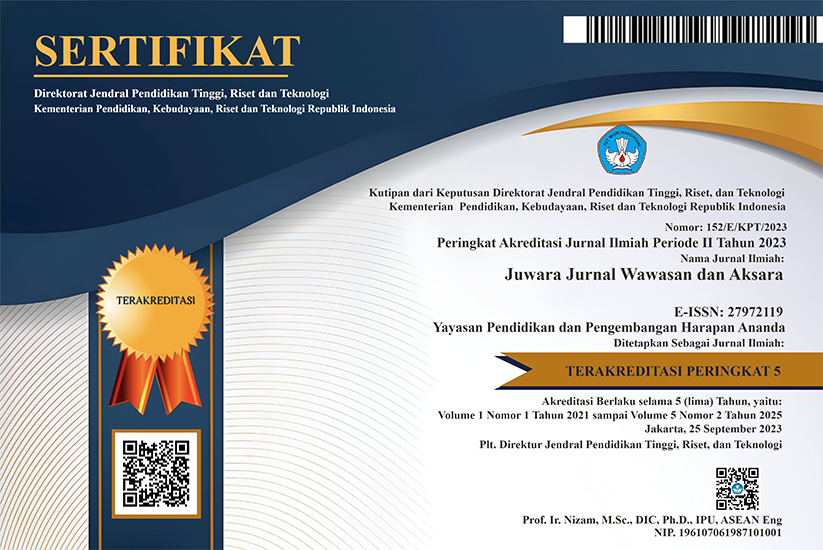Fashion Design Perception: a Comparative Study of Manual and Digital Methods
DOI:
https://doi.org/10.58740/juwara.v5i1.411Keywords:
design perception, digital design, fashion design, fashion technology, manual designAbstract
The fashion industry is undergoing a significant transformation with the integration of digital technology into the design process. This research aims to explore and compare perceptions of fashion designs generated through traditional manual methods and contemporary digital methods. The primary focus is to understand how audiences, both professionals and consumers, assess key aspects such as creativity, innovation, uniqueness, technical quality, and aesthetic appeal of these two design approaches. The proposed research method is a comparative study with a mixed-methods approach (quantitative and qualitative), involving surveys and in-depth interviews with designers, fashion design students, and consumers. The expected results will provide insights into the advantages and disadvantages of each design method from a perceptual perspective, as well as their implications for fashion design practice and education in the digital era. This research is expected to contribute to bridging the gap between traditional design practices and digital innovation, and to provide guidance for designers in choosing the most appropriate approach for their creative goals and target markets.
References
Khairulanwar, A. B. M., & Jamaludin, K. A. (2025). Artificial Intelligence in Fashion Design Education: A Phenomenological Exploration of Certificate-Level Learning. International Journal of Academic Research in Business and Social Sciences, 15(3), 313–331. http://dx.doi.org/10.6007/IJARBSS/v15-i3/24604
Canag, L. C., Loquinario, A. J. F., Pepano, R. M. V., & Peninoy, R. B. (2024). Democratizing fashion consumer engagement and redefining style in the digital age. International Journal of Research and Innovation in Social Science, 8(12), 935–949. https://doi.org/10.47772/IJRISS.2024.8120078
Daisie Blog. (2023). Pros & cons: Traditional vs digital fashion design. https://blog.daisie.com/pros-cons-traditional-vs-digital-fashion-design/
Fauzansyah, T. A., Edyan, R., & Hakiki, M. (2025). Project-based learning integrated with CAD software to improve technical drawing skills. Juwara: Jurnal Wawasan dan Aksara, 5(1), 115–125. https://doi.org/10.58740/juwara.v5i1.406
Gadi, A. C. Z., Triyanto, T., & Warno, K. (2025). Integration of combination embroidery technique in fashion design learning in vocational education. Juwara: Jurnal Wawasan dan Aksara, 5(1), 99–114. https://doi.org/10.58740/juwara.v5i1.405
Gupta, R., & Amal, M. A. (2025). Smart Systems and The Fashion Industry: The Shift from Manual Labor To Automated Systems. Cuestiones de Fisioterapia, 54(3), 3145-3150. https://doi.org/10.48047/CU
Huang, T. C., & Jin, M. (2024). Innovating sustainable fashion design: an exploration of the sustainability of a hybrid method through the C2CAD framework. International Journal of Fashion Design, Technology and Education, 1–11. https://doi.org/10.1080/17543266.2024.2436093
Indian Institute of Art and Design. (2023). Virtual reality in fashion: Pros & cons in digital fashion. https://www.iiad.edu.in/the-circle/virtual-reality-in-fashion/
Lee, N., & Suh, S. (2024). How Does Digital Technology Inspire Global Fashion Design Trends? Big Data Analysis on Design Elements. Applied Sciences, 14(13), 5693. https://doi.org/10.3390/app14135693
Liu, T. T., Tan, C. S. L., & Quintero Rodriguez, C. (2025). Virtual consumption in luxury brands: Consumer purchase motivations of virtual luxury fashion in virtual worlds. Journal of Fashion Marketing and Management, Advance online publication. https://doi.org/10.1108/JFMM-05-2024-0175
Mahanani, C., & Jerusalem, M. A. (2025). Exploring fashion purchase intentions in digital marketplaces: TAM perspectives among UNY students. Juwara: Jurnal Wawasan dan Aksara, 5(1), 68–80. https://doi.org/10.58740/juwara.v5i1.399
Mutlu Bar??. (2024). Fashion psychology: The effects of clothing on you and their psychological reflections. https://mutlubaris.com/en/articles/fashion-psychology-the-effects-of-clothing-on-you-and-their-psychological-reflections
Pratiwi, A., & Nugroho, B. (2025). Sensory experience in manual fashion design: Impact on consumer perception of authenticity. Juwara: Jurnal Wawasan dan Aksara, 5(1), 126–138. https://doi.org/10.58740/juwara.v5i1.407
Hoque, M.A., Rasiah, R., Furuoka, F. and Kumar, S. (2021), Technology adoption in the apparel industry: insight from literature review and research directions, Research Journal of Textile and Apparel, Vol. 25 No. 3, pp. 292-307. https://doi.org/10.1108/RJTA-08-2020-0090
Sholikhah, R., Widowati, W., & Atika, A. (2025). Development of 3D Virtual Fashion Design E-module Using CLO3D Software to Improve 21st Century Skills in Fashion Design Education. In The 8th International Conference on Education Innovation (ICEI 2024) (pp. 819-841). Atlantis Press. https://doi.org/10.2991/978-2-38476-360-3_72
Thompson, R. (2025). Designing desire: The role of semiotics in fashion branding. Visual Life. https://rikithompson.ds.lib.uw.edu/visuallife/designing-desire-the-role-of-semiotics-in-fashion-branding/
URCADServices. (2018). 5 advantages of manual drafting and CAD drafting. https://www.urcadservices.com/post/2018/01/04/five-advantages-of-manual-drafting-and-cad-drafting
Wang, Y., Li, J., & Chen, Y. (2024). Clothing design factors, aesthetic experience, and preference: Additional insights from neuromarketing in civil defense clothing. International Journal of Fashion Design, Technology and Education. https://www.tandfonline.com/doi/abs/10.1080/20932685.2024.2403378
Willem de Kooning Academie. (2025a). Me-you-us: Powering fashion education through digital making. https://www.wdka.nl/stories/me-you-us-powering-fashion-education-through-digital-making
Willem de Kooning Academie. (2025b). Me-you-us: Transforming fashion education with digital frameworks. https://www.wdka.nl/stories/me-you-us-transforming-fashion-education-with-digital-tools
Yen, HY., & Hsu, CI. (2017). College student perceptions about the incorporation of cultural elements in fashion design. Fash Text 4, 20. https://doi.org/10.1186/s40691-017-0105-1
Zhang, Y., & Liu, C. (2024). Unlocking the Potential of Artificial Intelligence in Fashion Design and E-Commerce Applications: The Case of Midjourney. Journal of Theoretical and Applied Electronic Commerce Research, 19(1), 654-670. https://doi.org/10.3390/jtaer19010035
Downloads
Published
How to Cite
Issue
Section
License
Copyright (c) 2025 Resi Sepsilia Elvera, Pramesti Adika Ratri, Nurkholifah, Diah Indah Pratiwi

This work is licensed under a Creative Commons Attribution-NonCommercial 4.0 International License.
JUWARA: Jurnal Wawasan dan Aksara provides open access to anyone so that the information and findings in these articles are useful for everyone. This journal's article content can be accessed and downloaded for free, following the creative commons license used.




















